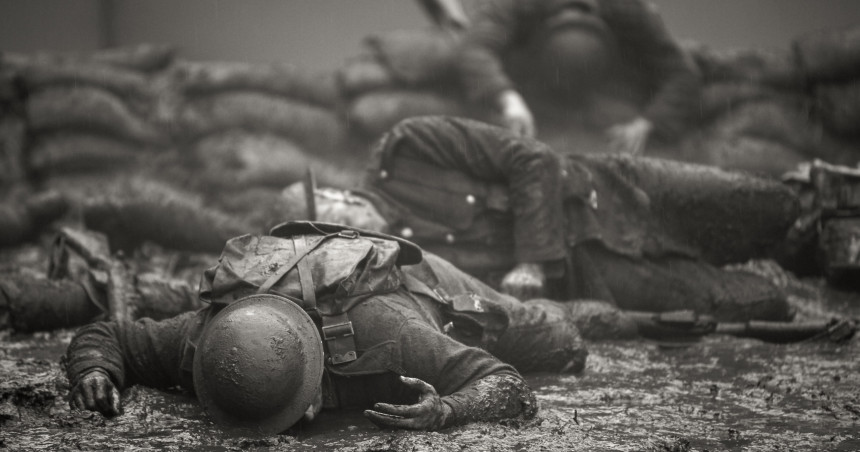What made the atomic bombings of Hiroshima and Nagasaki possible? Some might refer to America’s advanced technological capacity and the making of the atomic bomb as a game-changer. Others might debate whether the bombings were inevitable or justifiable.
But the most pertinent question is to consider how it even became imaginable for Americans to deploy such weaponry against their fellow human beings. The answer is altogether a disturbing one.
The use of the atom bomb was not only a particularly destructive type of weaponry — resulting in the deaths of more than 100,000 people — but rather an extension of the dehumanisation of the Japanese enemy in American media, years prior to the dropping of the bombs.
Japanese people seen as cockroaches!
The Japanese were painted as parasites, as rodents and cockroaches, as an infestation that had to be removed.
Where the lynchings of Black people in America was precipitated by a culture of stigmatising them as “niggers”, similarly, the label of “gooks” was used to otherise the Vietnamese in the My Lai massacre — in which hundreds of civilians were killed by American troops.
About this, Mark Baker offers us a haunting perspective from an interview held with a US soldier:
“I enjoyed the shooting and the killing. I was literally turned on when I saw a gook get shot. When a GI got shot, even if I didn’t know him … that would bother me. A GI was real. But if a gook got killed, it was like me going out here and stepping on a roach.” [1]
Posters likened Japanese people to vermin in need of extermination. Magazines depicted predatory Japanese soldiers kidnapping blonde American women.
One propaganda poster featured an image of a fist with “American Labor” written on the arm that punches the jaw of a caricatured Japanese person.
It reads,
“Don’t Save his Face! — Every Blow Counts in the Battle for Production.”
Another poster portrays Japanese people with subhuman features, with large, sharp teeth. Others have Japanese people as rats and rodents.
Long before the atom bombs fell, these images streamlined the indiscriminate firebombing of Japanese cities.
In Tokyo on 10 March 1945, at least 100,000 civilians died during a single raid. Only five months later, the United States detonated two atom bombs over the cities of Hiroshima and Nagasaki, killing up to 126,000 defenceless people.
The late American scholar Richard Barnet wrote,
“The people of Hiroshima and Nagasaki were about as defenceless against a high flying B-29 with an atomic bomb as the Jews in Hitler’s Europe were against the gas chambers and ovens…
“Although there was substantial evidence at the time that the Japanese were considering surrender, the two bombs were dropped ‘to save lives’.” [2]
In addition, Glenn Gray recounted an incident from WWII,
“When a Japanese soldier was ‘flushed’ from his hiding place well behind the lines of combat, the unit — made up of relatively green troops — was resting and joking. But they seized their rifles and began using him as a live target while he dashed frantically around the clearing in search of safety.
“The soldiers found his movements uproariously funny and were prevented by their laughter from making an early end of the unfortunate man.
“Finally, however, they succeeded in killing him, and the incident cheered the whole platoon, giving them something to talk and joke about for days afterwards.
“In relating this story … the veteran emphasised the similarity of the enemy soldier to an animal. None of the American soldiers apparently ever considered that he may have had human feelings of fear and the wish to be spared.” [3]
Robbing people of inherent human characteristics
Dehumanisation always starts with language, often followed by images. We see this throughout history.
During the Holocaust, Nazis described Jews as Untermenschen — subhuman. They called Jews rats and depicted them as disease-carrying rodents in everything from military pamphlets to children’s books.
Similarly, Hutus involved in the 1994 Rwanda genocide called Tutsis “cockroaches”. And to this day, indigenous people are often referred to as “savages”. During the 1992-95 genocide, Serbs called Bosnians “aliens”; slave owners throughout history have considered slaves to be subhuman animals.
It is clear that stereotypes are what skew a person’s perception of a group.
Indeed, Philip Limbardo writes that with the advent of the Iraq War, new corps of soldiers have derogated different-looking citizens and soldiers:
“Yesterday’s [Japanese] ‘gooks’ have become today’s ‘hajis and towel heads’.” [4]
Limbardo cites former US Army sergeant and latterly anti-war campaigner Camilo Mejla, as saying,
“You just sort of try to block out the act that they’re human beings and see them as enemies…
“You call them ‘hajis’, you know. You do all the things that make it easier to deal with killing them and mistreating them.” [4]
Cultural stereotypes during the Holocaust
People’s perceptions of others can sometimes confirm existing cultural stereotypes disseminated in the media, in school textbooks, films, religious centres, and among people.
In the Holocaust, when speaking of prisoners, Nazi guards avoided using names or words like “people”, “individuals”, or even “men”, referring to them instead as “pieces” or “items”.
The purpose was to strip victims of all importance and render their lives meaningless. Using words such as “corpse” or “victim” were forbidden; the dead were instead akin to blocks of wood, completely irrelevant.
In a secret memorandum dated 05 June 1942, the human beings marked for death in mobile gas chambers at Chełmno were always referred to as “the cargo” or “the items”. [5]
Perpetrators of genocide rarely see their victims as individuals, viewing them instead as a mass of bodies and corpses. When we hear of the deaths of thousands of victims, the number disallows a connection with each life. The atrocity indeed stands out, but the sorrow of a personal tragedy often escapes us.
Nazi guards had to ensure that identity cards were removed from their victims, that gas chambers took the place of summary executions, that victims were never addressed by their names or even in terms that remotely denoted a human presence.
“Dehumanisation is a blurring of distinctions”
The famous Stanford experiments and others conducted by Albert Bandura sought to demonstrate the power of dehumanising labels to generate a culture of otherness which would lead to the harming of others.
From these tests, the researchers showed that dehumanising others with caricatures and labels divested them of human qualities.
Conversely, their research also showed that positive labelling had the effect of enhancing a greater respect towards people.
The archetypes of terrorist or untrustworthy enemy created by visual propaganda in Nazi Germany of Jews, or the media portrayals of Arabs that the late writer Jack Shaheen and others point out, generate an idea of a dangerous “them”, as “outsiders” and “hostile”. [6]
The repeated use of such images, together with negative media narratives, creates an absurd societal paranoia about the burqa-attired woman or the heavily-bearded man.
Dehumanisation is a blurring of distinctions, a rendering of others as faceless, and unlike ourselves. And with the rise of drone warfare in our skies today, of remote-controlled air war, this has generated a new mode of depersonalised killings, of dehumanisation, distance, and detachment. [7]
In the polemic Drone Theory, Gregoire Chamayou explains,
“Thousands of miles can now be interposed between the trigger on which one’s finger rests and the cannon from which the cannonball will fly.” [8]
The mechanism of dehumanisation and the way it betrays the trueness of human conscience is illustrated in the deliberate efforts to look away from what lies before itself.
This is reflected in an account from a Japanese prison camp during WWII:
“The Japanese showed a sudden reluctance to meet our eyes in the course of our daily contacts. We knew that they were taking precautions to ensure that not a single glimpse of one’s obvious and defenceless humanity should slip through their defences and contradict the caricature some demoniac a priori image had made of us within them.
“The nearer the storm came, the more intense the working of this mechanism became. I had seen its most striking manifestation in the eyes of a Japanese officer who, with a condemned Ambonese soldier before him, had had to lean forward and brush the long black hair from the back of the neck over the head and eyes of the condemned man before he could draw his sword and cut off the man’s head.
“Before the blow fell, he had been compelled to look straight ahead over the doomed head, seeing neither it nor us who stood, raggedly, in a long line in front of him.” [9]
Trump presidency of 2017-2021 and his Mexican wall
An “other” is a result of a “self”’s paranoia about someone he has been led to fear and suspect, which is usually driven by politicians and the media, as opposed to personal contact.
Under Donald Trump’s presidency, the rhetoric he employed to caricature Mexicans as rapists and drug dealers furthered the normalisation of othering, making it more acceptable and even desirable to support calls for their deportation and for the building of a border wall.
Ironically, the wall is precisely what othering does! It divides and separates us. Othering is thus both socially and culturally created and peaks at moments of unease.
Human encounters, however, can have a remarkable effect of not only reversing stereotypes but also bridging the distinctions between people so that our differences are viewed in light of a shared humanity and a sign of the amazing creation of Allah.
What does Allah say about diversity and differences?
In the Qur’ān, Allah instructs the believers to address one another in fair terms, not to ridicule and insult one another, or to consider one’s self as being better than others.
The following verse in Sūrat al-Hujarāt cautions the faithful,
“O believers, no one group of men should jeer at another, who may, after all, be better than them; no one group of women should jeer at another, who may, after all, be better than them.
“Do not speak ill of one another; do not use offensive nicknames for one another. How bad it is to be called a mischief-maker after accepting faith! Those who do not repent of this behaviour are evildoers.” [10]
It is worth remembering that the European perception of Arabs, Muslims, and Turks as dark and devilish others emanated from Ottoman military engagements in the Balkans.
This played a most significant role in creating the other, as well as in self-image making:
“These attitudes thread through much of Church history, emerging notions of sovereignty, and European culture and self-image, and to some degree were handed on to Americans.” [11]
The Qur’ān makes clear that diversity and differences will always exist. Unlike the othering imputed on people for the colour of their skin, ethnicity, and languages, beliefs are instead chosen.
Without a clear understanding of human difference and the way Allah tells us to treat one another with respect to it, the diversity of belief may lead to disputes and conflict.
Though the Qur’ān invites to the belief and way of life best suited for human beings, it also acknowledges a freedom of belief and worship.
Others may choose to believe differently or worship other than Allah:
“Say, ‘Now the truth has come from your Lord: let those who wish to believe in it do so, and let those who wish to reject it do so’.” [12]
It is from Allah’s infinite wisdom that He created us different in shapes, languages, colours, beliefs, customs, and traditions.
As He (subḥānahu wa ta’āla) says,
“We have assigned a law and a path to each of you. If God had so willed, He would have made you one community, but He wanted to test you through that which He has you, so race to do good: you will all return to God and He will make clear to you the matters you differed about.” [13]
Moreover, He states,
“O humanity, We created you all from a single man and a single woman, and made you into races and tribes so that you should recognise one another. In God’s Eyes, the most honoured of you are the ones most mindful of Him: God is all knowing, all aware.” [14]
And,
“Another of His signs is the creation of the Heavens and Earth, and the diversity of your languages and colours. There, truly, are signs in this for those who know.” [15]
It is natural that we notice our differences in nationality, ethnicity, and race. But to otherise on account of these factors is to render those different to us as “outside”, “foreign”, and “alien”.
What can often stem from this is cultural and military subordination of a dominant group over an inferior other.
In the Prophet Muhammad’s last sermon during the Hajj in the tenth year of Hijrah, he (ﷺ) made clear that all people are equal, irrespective of ethnicity or colour. And that the only thing that differentiates them is their acknowledgement, belief, fear, trust, and love of Allah (taqwa).
It is this that motivates us to good actions and makes us cognisant of personal and social responsibilities.
As the Prophet (ﷺ) declared,
“There is no superiority for an Arab over a non-Arab and for a non-Arab over an Arab; or for white over the black, or for the black over the white, except in piety.
“Verily, the noblest among you is he/ she who is the most pious.” [16]
Action points
-
Be understanding of others' differences, and recognise that some people may not believe in the way we do.
-
Stereotypes and negative cultural labels must be nipped in the bud, so as to prevent manifestation of hatred toward others.
-
Islam provides the guidelines when it comes to everything; taqwa is what truly differentiates us from others.
Source: Islam21c
Notes
[1] Sam Keen, Faces of the Enemy (Harper & Row, San Francisco: 1986), p. 125.
[2] Richard Barnet, Roots of War (Penguin Books, Maryland: 1973), p. 17.
[3] Sam Keen, Faces of the Enemy (Harper & Row, San Francisco: 1986), p. 62.
[4] Philip Zimbardo, The Lucifer Effect: How Good People Turn Evil (Rider Books: 2007), pp 307-308; C.J. Nemeth, “Differential Contributions to Majority and Minority Influence,” Psychological Review 93 (1986), pp. 23-32.
[5] Osman Latiff, On Being Human: how Islam addresses othering, dehumanisation, and empathy (Sapience Institute, 2020),p. 70.
[6] J. Shaheen, Reel bad Arabs: How Hollywood vilifies a people (New York: Olive Branch Press: 2001).
[7] Osman Latiff, On Being Human: how Islam addresses othering, dehumanisation, and empathy (Sapience Institute, 2020), p. 131.
[8] Grégoire Chamayou, Drone Theory (trans. Janet Lloyd) (Paris, The New Press: 2015), p. 12.
[9] Larens Van der Post, Merry Christmas, Mr. Lawrence (New York: Quill, 1983), p. 153.
[10] al-Qur’ān, 49:11
[11] John Tirman, The Death of Others: The Fate of Civilians in America’s Wars (Oxford: Oxford University Press), p. 345; see Osman Latiff, On Being Human: how Islam addresses othering, dehumanisation, and empathy (Sapience Institute, 2020), p. 73.
[12] al-Qur’ān, 18:29
[13] al-Qur’ān, 5:48
[14] al-Qur’ān, 49:13
[15] al-Qur’ān, 39:22
[16] Ahmad 22978; Osman Latiff, On Being Human: how Islam addresses othering, dehumanisation, and empathy (Sapience Institute, 2020), p. 83.









